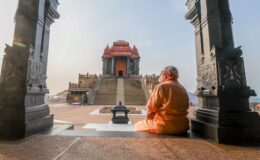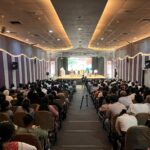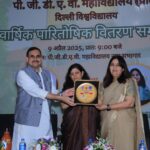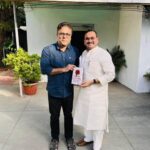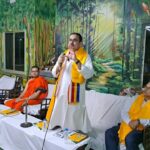CIVILISATIONAL DIALOGUE AT SAMVAD IN YANGON
- By : Anirban Ganguly
- Category : Articles
Modi’s vision of India’s civilisational outreach was in full display at the second Samvad gathering: It generated goodwill, confidence and an urge towards a greater synthesis of thought, of direction and of action
Despite political vicissitudes, despite the many layers of our relations over the decades, despite challenging phases as well as promising ones, the essentials of India and Myanmar relations continue to be based on civilisational fundamentals — from the very ancient past to the present times. Sacred strands of Sakyamuni’s hair bind the two countries for eternity as it were. The significance of Prime Minister Narendra Modi visiting Myanmar at regular intervals in the last three years, his upcoming visit — the first bilateral — in the first week of September this year, will further cement and impart new and contemporary vigour to this ancient tie. Yangon, therefore, as a setting for the Samvad-II: Dialogue for Peace, Harmony and Security — A Global Initiative for Conflict Avoidance and Environment Consciousness, was for those who immerse themselves in trying to discern civilisational parallels, highly symbolic and significant.
The leading and pre-eminent Sitagu International Buddhist Academy, led by the venerable Ashin Nyanissara, was the local host and driving force, while the Vivekananda International Foundation, the Government of Myanmar, the Myanmar Institute of Strategic and International Studies and the Japan Foundation extended their support and expertise to make the event a meaningful exercise in dialogue — Samvad. Daw Aung San Suu Kyi took special interest, closely following the proceedings and despatching her National Security Advisor for two days.
Prime Minister Narendra Modi and Prime Minister Shinzo Abe sent their special messages for the occasion, each articulating the deeper theme and imparting an inaugural direction to the exercise. Modi’s call was to “cut through deep rooted religious stereotypes and prejudices” through the medium of Samvad and to address the fundamental questions facing mankind today, questions such as “how to avoid conflict”, “how to address a global challenge like climate change” and “how to live in peace and harmony and secure our lives.” Modi pointed out how, “Asia’s oldest traditions of dialogue and debate” can guide a 21st century world that is increasingly “interconnected and inter-dependent” and is battling a “number of global challenges, from terrorism to climate change.” It was a “deep and prolonged dialogue” which can “produce synergies and resolve contradictions”, he observed.
Prime Minister Abe’s message synchronised with the words and vision of Prime Minister Modi. “Terrorism and violent extremism is expanding and trying to deny the existence of ‘others’ and to paint our world in a single colour”, Abe observed, “Such attempts should not be tolerated. In Asia, we must let flowers of all different colours bloom in harmony. Finally, freedom, which brings tolerance and diversity, is the source of growth and creativity. Asia’s significant development that we enjoy today is based on freedoms of thought, speech and commerce that those before us have carefully nurtured. Free, open, diverse and tolerant Asia; Asia where nobody is excluded; Asia, where sustainable growth is realised, these are the values that Japan would like to realise.” Interestingly, Abe spoke of evolving a “Free and Open Indo-Pacific Strategy” which would nurture and protect the freedom of civilisational interaction and positive exchange in the region and beyond.
The Hindu Dharma Acharya Sabha was representated by the most sacred collective of Hindu Swamis led by Mahamandaleshwar Swami Avdheshanand Giri Maharaj, saw the presence of Swami Nirmalanandanatha, head of the Adichunchanagiri math, Swami Paramatmanandaji, Govind Dev Giri Maharaj, Swami Mitrananda, Lokesh Muni, Swami Chidananda Muni, the Jathedar of the iconic Takht Sri Patna Sahib gurdwara and a host of others who participated in the deliberations and extensively engaged with leaders from other religions, in closed interactions discussing various dimensions, challenges and the way forward. Apart from a host of scholars presenting their thoughts on the principle theme of Samvad, these intense and focused engagements were crucial and formed the bedrock of the exercise.
Uttar Pradesh Chief Minister Yogi Adityanath, himself a foremost representative of the Nath Sampradaya, which is, as he observed an “excellent example of the composite Hindu and Buddhist faiths and their philosophical religious traditions”, delivered the valedictory address, pointing out how he had come from a state that was rich in Buddha’s and Ram’s legacy. Guru Gorakhnath is regarded as one of the 84 Siddhas of the Mahayana Buddhist tradition, and is known as ‘Goraksh’ in the Tibetan Buddhist tradition. In a moving and powerful address, Yogi Adityanath drew a deep civilisational parallel, between the two religions, and expanded on how their wisdom and traditions can indeed lay a distinct path ahead in addressing the major challenges of the world. Yogi Adityanath pointed out how India, and especially his State, was the inheritor of the legacy of Ram, Krishna and Buddha and was committed to work for the welfare of one and all through pursuing the path of Sabka saath, Sabka vikas.
For the assembled international audience and the large number of scholar monks, it was indeed an interesting sight to see and to hear a monk from India —who embodied in himself the dimensions of a spiritual leader, a popular political leader, a parliamentarian and an administrator and whose actions through renunciation seem to be giving him greater impetus and dynamism. This was a new aspect of the Samvad effort. Uttar Pradesh Governor, the venerable Ram Naik, also participated in the deliberations, both he and Yogi Adityanath represented that the Indian State, which has one of the strongest civilisational and historical association with Buddhism and Hinduism.
The 10-point Yangon Samvad declaration, jointly authored by the hosts and the participating organisations and country, among other things, declared to stand firmly against “all kinds of hate speech, false propaganda, conflict and war under the pretext of religion” and strongly condemned “those who provide support to any such activities.” The members and leaders of different faiths and all those gathered affirmed that they needed to “build mutual understanding, respect and trust” among themselves in order to obtain a peaceful, secure and prosperous human society.” They also resolved to “exercise restraint and refrain from interfering in matters of other religions and to cooperate in building bridges for world peace.” It was also declared that collective projects and efforts will be initiated for enhancing environmental consciousness. It was particularly significant, especially in the global context, that the declaration, affirmed at the end that “all spiritual paths and religious traditions are equally valid”, implying that there was no single path or single way.
The response from the people and from the intelligentsia in Myanmar was extremely positive and forthcoming; there was a great interest among them to be part of this initiative. The dimensions of civilisation, of culture and the dimensions of traditions and knowledge were activated to generate a new grand narrative — a narrative that is dharmik and aspires to create a contemporary framework of civilisational engagement. One recalled Prime Minister Modi’s words while inaugurating the first Samvad in Delhi in 2015, where he had said, “They say that this century is going to be an Asian century. I am very clear that without embracing the path and ideals shown by Buddha, this century cannot be an Asian century!” One saw that in action in Yangon, where Buddha and Vivekananda mingled, where the principles of dharma were reiterated and articulated to shape that Asian century, guided by India’s civilisational wisdom, experience and their many manifestations over the centuries.
The defining feature of Narendra Modi’s vision of India’s civilisational outreach was in full display — it generated goodwill, confidence and an urge towards a greater synthesis of thought, of direction and of action.
(This is the second and final article in a two-part series on Samvad.)



